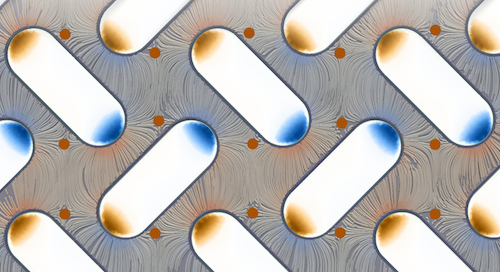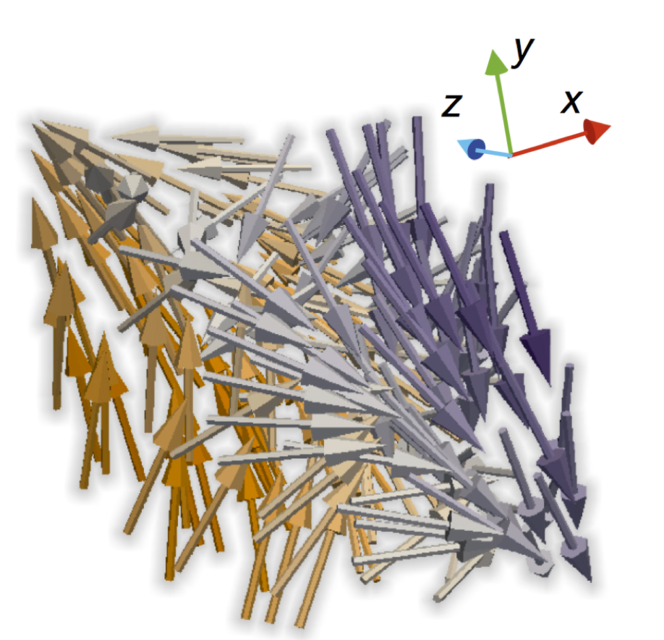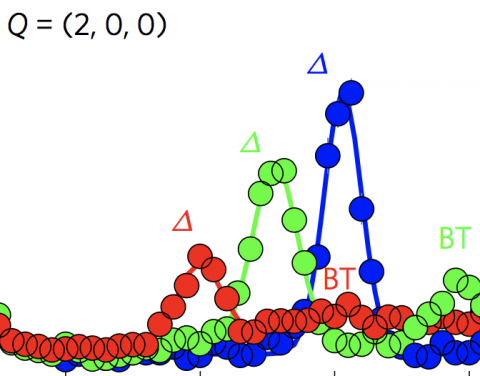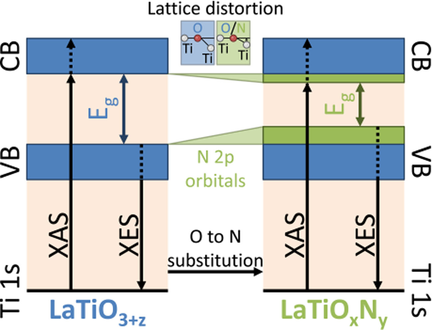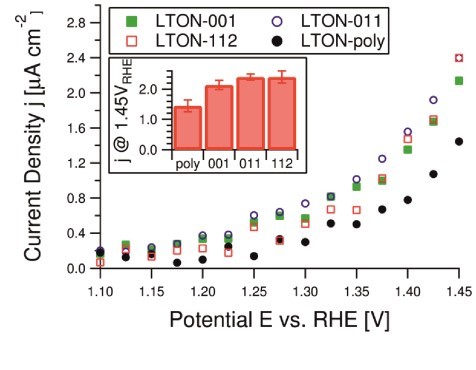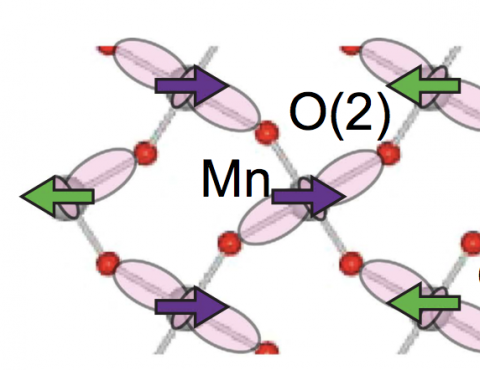Scientific Highlights 2017
In soft ferromagnetic materials, the smoothly varying magnetization leads to the formation of fundamental patterns such as domains, vortices and domain walls. These have been studied extensively in thin films of thicknesses up to around 200 nanometres, in which the magnetization is accessible with current transmission imaging methods that make use of electrons or soft X-rays. In thicker samples, however, in which the magnetization structure varies throughout the thickness and is intrinsically three dimensional, determining the complex magnetic structure directly still represents a challenge. We have developed hard-X-ray vector nanotomography with which to determine the three-dimensional magnetic configuration at the nanoscale within micrometre-sized samples. We imaged the structure of the magnetization within a soft magnetic pillar of diameter 5 micrometres with a spatial resolution of 100 nanometres and, within the bulk, observed a complex magnetic configuration that consists of vortices and antivortices that form cross-tie walls and vortex walls along intersecting planes. At the intersections of these structures, magnetic singularities—Bloch points—occur. These were predicted more than fifty years ago but have so far not been directly observed. Here we image the three-dimensional magnetic structure in the vicinity of the Bloch points, which until now has been accessible only through micromagnetic simulations, and identify two possible magnetization configurations: a circulating magnetization structure and a twisted state that appears to correspond to an ‘anti-Bloch point’. Our imaging method enables the nanoscale study of topological magnetic structures in systems with sizes of the order of tens of micrometres. Knowledge of internal nanomagnetic textures is critical for understanding macroscopic magnetic properties and for designing bulk magnets for technological applications.
17 July 2017
4-spin plaquette singlet state in the Shastry–Sutherland compound SrCu2(BO3)2
The study of interacting spin systems is of fundamental importance for modern condensed-matter physics. On frustrated lattices, magnetic exchange interactions cannot be simultaneously satisfied, and often give rise to compet- ing exotic ground states. The frustrated two-dimensional Shastry–Sutherland lattice realized by SrCu2(BO3)2 is an important test to our understanding of quantum magnetism. It was constructed to have an exactly solvable 2-spin dimer singlet ground state within a certain range of exchange parameters and frustration. While the exact dimer state and the antiferromagnetic order at both ends of the phase diagram are well known, the ground state and spin correlations in the intermediate frustration range have been widely debated. We report here the first experimental identification of the conjectured plaquette singlet intermediate phase in SrCu2(BO3)2. It is observed by inelastic neutron scattering after pressure tuning at 21.5kbar. This gapped singlet state leads to a transition to an ordered Neel state above 40 kbar, which can realize a deconfined quantum critical point.
12 May 2017
Determination of Conduction and Valence Band Electronic Structure of LaTiOxNy Thin Film
Abstract:
The nitrogen substitution into the oxygen sites of several oxide materials leads to a reduction of the band gap to the visible-light energy range, which makes these oxynitride semiconductors potential photocatalysts for efficient solar water splitting. Oxynitrides typically show a different crystal structure compared to the pristine oxide material. As the band gap is correlated to both the chemical composition and the crystal structure, it is not trivial to distinguish which modifications of the electronic structure induced by the nitrogen substitution are related to compositional and/or structural effects. Here, X-ray emission and absorption spectroscopy are used to investigate the electronic structures of orthorhombic perovskite LaTiOxNy thin films in comparison with films of the pristine oxide LaTiOx with similar orthorhombic structure and cationic oxidation state. Experiment and theory show the expected upward shift in energy of the valence band maximum that reduces the band gap as a consequence of the nitrogen incorporation. This study also shows that the conduction band minimum, typically considered almost unaffected by nitrogen substitution, undergoes a significant downward shift in energy. For a rational design of oxynitride photocatalysts, the observed changes of both the unoccupied and occupied electronic states have to be taken into account to justify the total band-gap narrowing induced by the nitrogen incorporation.
3 April 2017
LaTiOxNy thin film model systems for photocatalytic water splitting: physicochemical evolution of the solid-liquid interface and the role of the crystallographic orientation
Abstract:
The size of the band gap and the energy position of the band edges make several oxynitride semiconductors promising candidates for efficient hydrogen and oxygen production under solar light illumination. The intense research efforts dedicated to oxynitride materials have unveiled the majority of their most important properties. However, two crucial aspects have received much less attention. One is the critical issue of the compositional/structural surface modifications occurring during operation and how these affect the photoelectrochemical performance. The second concerns the relation between the electrochemical response and the crystallographic surface orientation of the oxynitride semiconductor. These are indeed topics of fundamental importance since it is exactly at the surface where the visible light-driven electrochemical reaction takes place.
In contrast to conventional powder samples, thin films represent the best model system for these investigations. This study reviews current state-of-the-art of oxynitride thin film fabrication and characterization before focusing on LaTiO2N selected as representative photocatalyst. We report the investigation of the initial physicochemical evolution of the surface. Then we show that, after stabilization, the absorbed photon-to-current conversion efficiency of epitaxial thin films can differ by about 50% for different crystallographic surface orientations and be up to 5 times larger than for polycrystalline samples.
In contrast to conventional powder samples, thin films represent the best model system for these investigations. This study reviews current state-of-the-art of oxynitride thin film fabrication and characterization before focusing on LaTiO2N selected as representative photocatalyst. We report the investigation of the initial physicochemical evolution of the surface. Then we show that, after stabilization, the absorbed photon-to-current conversion efficiency of epitaxial thin films can differ by about 50% for different crystallographic surface orientations and be up to 5 times larger than for polycrystalline samples.
20 March 2017
Tuning the multiferroic mechanisms of TbMnO3 by epitaxial strain
Abstract:
A current challenge in the field of magnetoelectric multiferroics is to identify systems that allow a controlled tuning of states displaying distinct magnetoelectric responses. Here we show that the multiferroic ground state of the archetypal multiferroic TbMnO3 is dramatically modified by epitaxial strain. Neutron diffraction reveals that in highly strained films the magnetic order changes from the bulk-like incommensurate bc-cycloidal structure to commensurate magnetic order. Concomitant with the modification of the magnetic ground state, optical second-harmonic generation (SHG) and electric measurements show an enormous increase of the ferroelectric polarization, and a change in its direction from along the c- to the a-axis. Our results suggest that the drastic change of multiferroic properties results from a switch of the spin-current magnetoelectric coupling in bulk TbMnO3 to symmetric magnetostriction in epitaxially-strained TbMnO3. These findings experimentally demonstrate that epitaxial strain can be used to control single-phase spin-driven multiferroic states.
